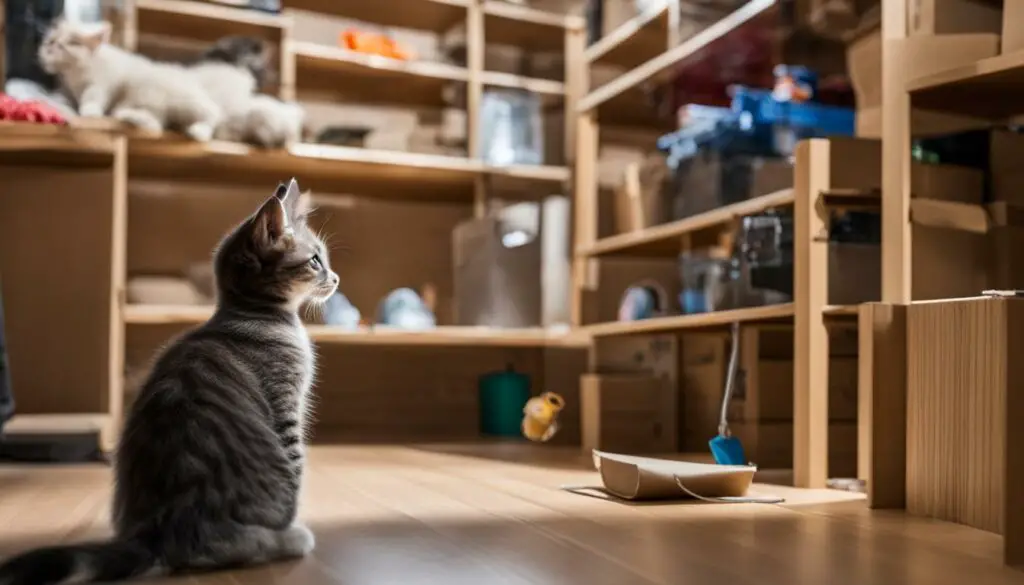Welcome to my quick guide on how to kitten proof a room! As a proud cat owner myself, I understand the importance of creating a safe and enjoyable environment for our furry friends. Kitten-proofing your home is a crucial step in ensuring their safety and preventing any potential accidents or hazards.
In this article, I will share with you some valuable kitten proofing tips and techniques to help you create a room that is both safe and fun for your adorable little companion. By following these steps, you can provide a secure space where your kitten can explore, play, and thrive.
Key Takeaways:
- Creating a safe environment is essential for your kitten’s well-being.
- Adjust your budget to accommodate the needs of your new furry friend.
- Allocate dedicated time in your schedule for bonding and interaction.
- Maintain a clean and tidy living space to minimize potential hazards.
- Restrict access to unauthorized areas by using doors and pet gates.
Now that we have covered the introduction, let’s delve into the detailed steps of kitten proofing a room. Let’s get started!
Adjusting Your Budget for Your New Kitten
Bringing a new kitten into your home is an exciting time, but it’s important to consider the financial aspects of pet ownership. Adjusting your budget to accommodate your kitten’s needs is crucial for their health and happiness. Beyond the initial adoption or purchase cost, there are ongoing expenses to keep in mind.
One of the major costs associated with owning a kitten is their food. High-quality, nutritious cat food is essential for their overall well-being. Additionally, regular veterinary visits, vaccinations, and preventative care can add up over time. It’s important to factor in these expenses when adjusting your budget.
Another consideration is the cost of essential cat supplies. These include items such as litter boxes, bedding, scratching posts, toys, and grooming tools. Investing in these items upfront will provide your kitten with the necessary resources for a happy and comfortable life.
| Expense | Estimated Cost |
|---|---|
| Adoption or Purchase | $50-$200 |
| Food | $20-$50 per month |
| Veterinary Care | $200-$400 per year |
| Supplies | $100-$200 (initial setup cost) |
Adjusting your budget to meet your kitten’s needs is an essential part of responsible pet ownership. By planning ahead and accounting for the necessary expenses, you can provide your furry friend with a happy and healthy life.
Remember, while the financial responsibilities of owning a kitten are important, the love and companionship they bring are priceless. With proper budgeting and planning, you can ensure that your new kitten receives the care and attention they deserve.
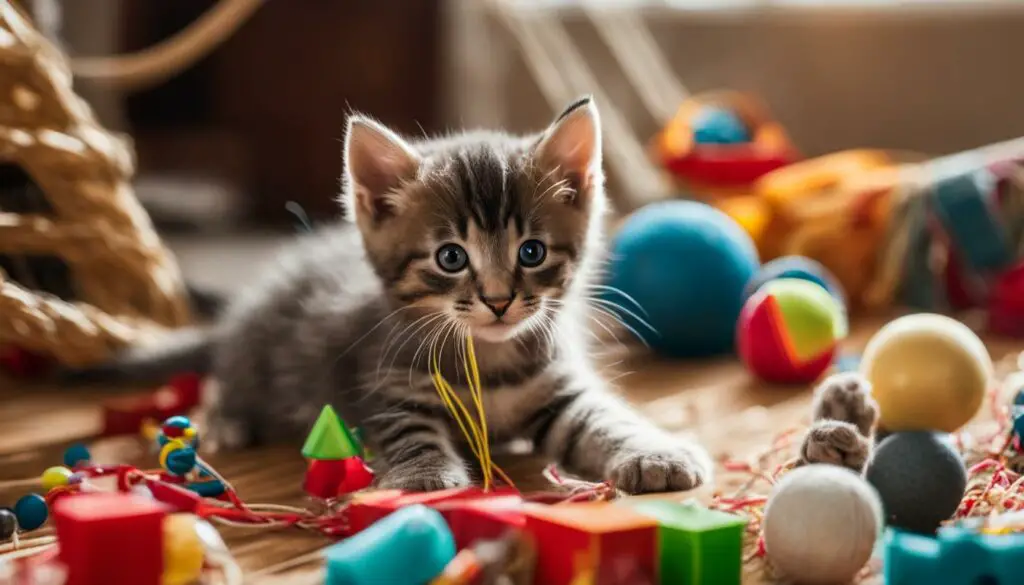
Additional Considerations
- Consider pet insurance as a way to mitigate unexpected veterinary costs.
- Research local veterinary clinics to find the best value for routine care.
- Look for deals and discounts on cat food and supplies to help stretch your budget.
- Consider setting aside a pet emergency fund for unexpected medical expenses.
Allocating Time in Your Schedule for Your Kitten
Kittens are adorable and require lots of attention and love. It’s important to set aside dedicated time in your schedule to bond with your new furry friend and meet their needs. Spending quality time with your kitten not only strengthens your relationship but also helps prevent any potential behavioral issues.
Here are some tips on how to allocate time in your schedule for your kitten:
- Playtime: Set aside specific times during the day to engage in playtime activities with your kitten. Use interactive toys to stimulate their senses and provide mental and physical exercise.
- Cuddling and grooming: Kittens love affection and enjoy being cuddled and groomed. Allocate time each day to cuddle and groom your kitten, which not only strengthens the bond between you but also helps keep their coat healthy and shiny.
- Training sessions: Spending time training your kitten is important for their overall development and behavioral training. Allocate short sessions each day to teach them basic commands and encourage positive behaviors.
- Mealtime: Use mealtime as an opportunity to spend quality time with your kitten. Sit with them while they eat and engage in gentle conversation or praise to create a positive association with mealtime.
Remember, each kitten has their own unique personality and preferences. Observe and understand your kitten’s needs and adjust your schedule accordingly to ensure they receive the attention and care they require. By allocating time in your schedule for your kitten, you can create a loving and fulfilling relationship that will last a lifetime.
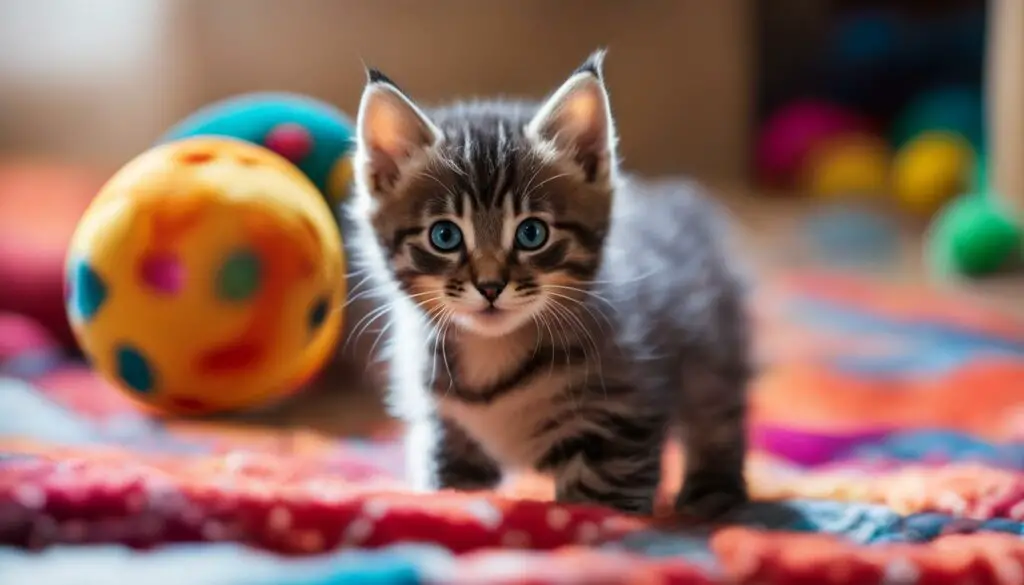
I love spending time with my kitten. It’s a chance for us to bond and create special memories together. Whether it’s playing, cuddling, or training, every moment spent with my furry friend is precious. By allocating time in my schedule for my kitten, I ensure that their needs are met, and our relationship grows stronger each day.
Creating a Clean and Tidy Environment
Kittens are naturally curious and have a knack for getting into trouble. To keep them safe and prevent accidents, it’s important to create a clean and tidy environment in your home. A clutter-free space not only minimizes potential dangers but also provides a calming and stress-free atmosphere for your furry friend.
One of the first steps in maintaining a clean environment is to declutter your living space. Remove any items that could pose a hazard to your kitten, such as loose cables, small objects, or toxic plants. Keep in mind that kittens have a tendency to chew on things, so make sure to secure any cords or wires and store household chemicals out of their reach.
Regular cleaning is also essential to ensure a clean and hygienic environment for your kitten. Vacuum or sweep the floors regularly to remove any loose debris or potential choking hazards. Clean up any spills or messes promptly to prevent your kitten from ingesting harmful substances. It’s also important to wash your kitten’s bedding and toys regularly to keep them clean and free from germs.
Maintaining a Clean Litter Box
Another crucial aspect of a clean and tidy environment is maintaining a clean litter box. Ensure that the litter box is scooped daily and completely emptied and cleaned at least once a week. Use a litter that is safe for kittens and absorbent to control odors effectively. Placing the litter box in a quiet and easily accessible area will encourage your kitten to use it consistently.
| Benefits of a Clean Environment | Tips for Maintaining a Clean Environment |
|---|---|
| Prevents accidents and injuries | Declutter your living space |
| Promotes a stress-free atmosphere | Secure cords and wires |
| Ensures a hygienic living environment | Store household chemicals out of reach |
| Reduces the risk of illness and infections | Regularly clean floors and surfaces |
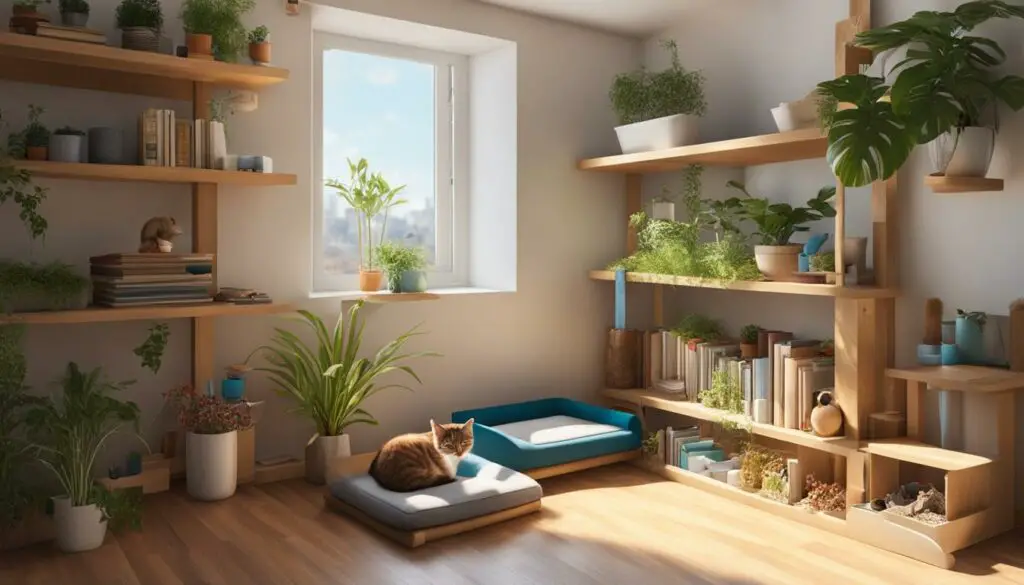
Remember, a clean and tidy environment not only keeps your kitten safe but also contributes to their overall well-being. So, regularly declutter, clean up, and maintain a clean litter box to provide a comfortable and healthy space for your furry friend.
Section 5: Restricting Access to Unauthorized Areas
When it comes to ensuring the safety of your kitten, restricting access to unauthorized areas is crucial. By closing doors or using pet gates, you can create a controlled and secure environment for your furry friend. This helps prevent accidents and keeps your kitten safe from potential dangers.
To promote kitten safety, there are a few key areas in your home that you should consider restricting access to. For example, keeping the toilet lids closed prevents your kitten from drinking or playing in the water, which can lead to health issues. Additionally, securing garbage cans with lids prevents your curious kitten from accessing harmful substances or choking hazards.
Stairways pose a significant risk to kittens, especially when they are exploring and learning to navigate their surroundings. By preventing access to stairways using pet gates, you can avoid potential falls or injuries. It’s essential to make sure that the gates are securely in place and cannot be easily pushed aside by your energetic kitten.
| Unauthorized Areas | Restrictions |
|---|---|
| Toilet | Keep lids closed to prevent access to water |
| Garbage cans | Secure with lids to prevent access to harmful substances |
| Stairways | Use pet gates to restrict access and prevent falls |
By restricting access to these unauthorized areas, you can create a controlled and safe environment for your kitten to explore. It’s important to remember that while you may have restricted access to certain areas, providing alternative safe spaces and enriching activities for your kitten is essential to ensure their well-being and happiness.
Removing Potential Hazards
When kitten-proofing a room, it’s important to identify and remove potential hazards that could harm your furry friend. Take stock of your home and ensure that items such as small objects, toxic substances, and hazardous plants are kept out of their reach.
Toxic items can pose a significant threat to your kitten’s health. Examples include cleaning products, certain houseplants, and human medications. Keep these items securely stored in cabinets or high shelves, where your kitten cannot access them.
Additionally, it’s crucial to remove small objects that your kitten may swallow and choke on. This can include small toys, loose buttons, and jewelry. Be diligent about keeping these items out of their reach, and always be mindful of the potential dangers.
| Hazard | Safety Measure |
|---|---|
| Toxic household chemicals | Store them in locked cabinets or high shelves |
| Hazardous plants | Remove them from the room or place them out of reach |
| Small objects | Keep them stored in containers or drawers |
Remember, prevention is the key to keeping your kitten safe. By removing potential hazards from their environment, you can create a secure space for them to explore and play.

My Story: A Close Call
I once had a close call with my kitten when she managed to knock over a bottle of cleaning solution left on a low shelf. Luckily, I had taken the precaution of securing the cap tightly, preventing any leaks or spills. However, it served as a reminder of how important it is to remove potential dangers from her reach. Now, I’m extra cautious about storing chemicals in a locked cabinet, ensuring her safety at all times.
Investing in Essential Cat Furniture and Equipment
Creating a cat-friendly environment for your kitten involves investing in essential cat furniture and equipment. These items not only provide comfort and entertainment but also cater to their natural instincts. Here are some must-have items to consider:
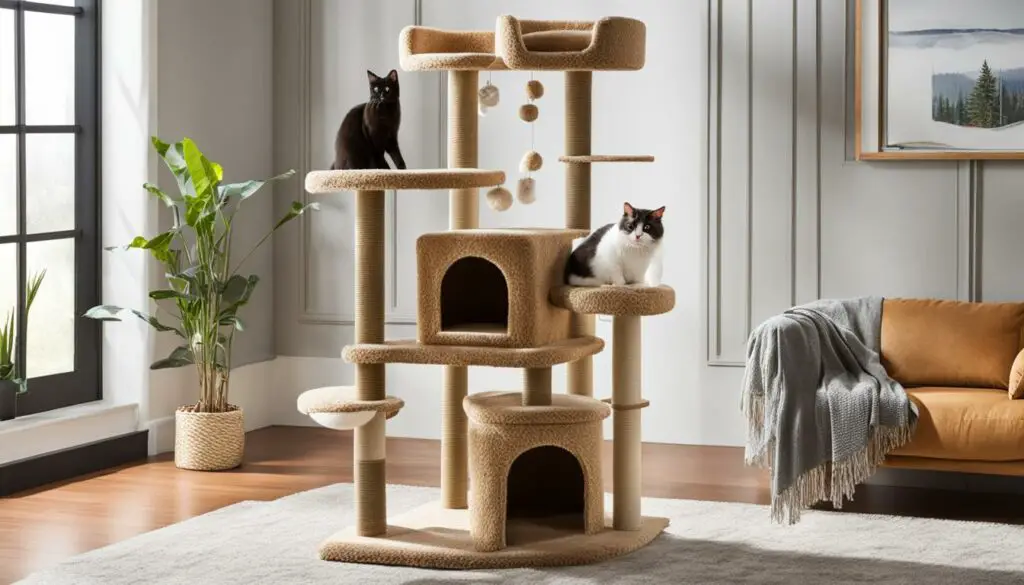
Litter Box
A clean litter box is essential for your kitten’s hygiene. Choose a litter box with low sides for easy access, and opt for flushable cat litter for convenience. Place the litter box in a quiet and private area to ensure your kitten feels comfortable using it.
Scratching Posts
Scratching posts are crucial for your kitten’s well-being. They provide an outlet for their natural scratching behavior, help keep their nails trimmed, and prevent furniture damage. Opt for sturdy and tall scratching posts that allow your kitten to stretch fully.
Enrichment Toys
Enrichment toys are vital for mental stimulation and entertainment. Interactive toys, puzzle feeders, and catnip-filled toys can keep your kitten engaged and prevent boredom. Rotate toys regularly to maintain their interest. However, ensure that the toys are safe and durable to avoid any choking hazards.
Cat Shelves and Perches
Cat shelves and perches offer elevated spaces for your kitten to explore and observe their surroundings. These elevated surfaces cater to their natural climbing instincts and provide a sense of security. Install shelves and perches in various heights to create a vertical playground for your furry friend.
By investing in these essential cat furniture and equipment, you can provide a cat-friendly space that meets your kitten’s needs for comfort, stimulation, and play.
Engaging in Enrichment Activities
One of the key aspects of ensuring your kitten’s well-being is engaging in enrichment activities that promote their mental stimulation and overall happiness. Just like humans, kittens need mental exercise to keep their minds sharp and prevent boredom. By incorporating various enrichment activities into their daily routine, you can provide a stimulating environment for your furry friend and foster their natural instincts.
Here are some enriching activities you can engage in with your kitten:
- Puzzle toys: These interactive toys challenge your kitten’s problem-solving skills, keeping them engaged and entertained for hours. Fill puzzle toys with treats or small toys to encourage exploration and mental stimulation.
- Hunting games: Mimic a hunting experience for your kitten by using feather toys or small plush animals. Move them around to imitate prey, allowing your kitten to chase and pounce, satisfying their natural instincts.
- Regular exercise: Set aside dedicated playtime to engage in active play with your kitten. Use toys that they can chase, jump, and bat around to keep them physically active and mentally stimulated.
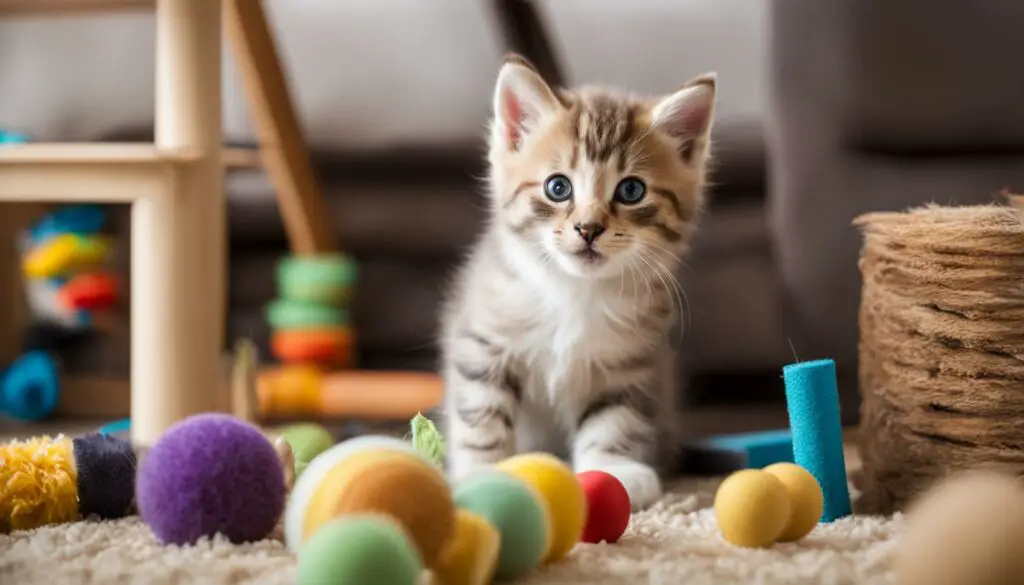
Additionally, it is crucial to consider spaying or neutering your kitten. Apart from preventing unwanted pregnancies, spaying or neutering can also help reduce hormone-driven destructive behaviors, such as spraying or aggression. This procedure not only promotes your kitten’s overall well-being but also creates a safer and more harmonious home environment for both of you.
Ensuring Safety During the Adoption Process
When it comes to adopting a kitten, ensuring a safe and responsible adoption process is crucial. By taking the necessary precautions, you can provide a loving home for a kitten in need and promote responsible pet ownership. Here are some important steps to consider:
- Choose a reputable shelter or rescue organization: Opting to adopt from a reputable shelter or rescue organization is essential. These organizations prioritize the well-being of their animals and provide proper veterinary care and socialization.
- Ask questions and gather information: Before adopting, ask questions about the kitten’s background, health history, and any behavioral issues. This will help you make an informed decision and ensure that the kitten is a good fit for your home and lifestyle.
- Schedule a veterinary check-up: As soon as you bring your new kitten home, schedule a veterinary check-up. This will ensure that they receive necessary vaccinations, are tested for any underlying health conditions, and are provided with preventative care.
- Prepare your home: Before bringing your new kitten home, make sure your living space is kitten-proofed. Remove any potential hazards, secure cords and blinds, and ensure that toxic substances are inaccessible. Creating a safe environment is essential for your kitten’s well-being.
- Introduce your kitten to their new home gradually: Provide a designated area for your kitten to settle in initially, gradually introducing them to the rest of your home. This will allow them to acclimate at their own pace and feel safe in their new surroundings.
By following these steps, you can ensure a safe and smooth adoption process, setting the foundation for a happy and healthy life with your new furry friend.

Quote:
“Adopting a kitten is a wonderful experience, but it’s important to prioritize their safety and well-being throughout the adoption process.” – Me
Thinking Like a Cat for Effective Kitten Proofing
When it comes to kitten proofing a room, it’s important to step into the feline world and think like a cat. By understanding their perspective and identifying potential dangers, you can create a safe and secure environment for your new furry friend. Here are some tips on how to think like a cat when kitten proofing:
1. Consider their natural instincts
Cats are curious creatures with a strong sense of exploration. Keep in mind their natural instincts when kitten proofing a room. Consider the surfaces they can jump on, the places they can hide, and the objects that might tempt their curiosity. By doing so, you can anticipate potential hazards and take proactive measures to address them.
2. Look for hiding spots and potential escape routes
Cats love finding cozy hiding spots and exploring small spaces. Take a close look at your room and identify any potential hiding spots, such as open cabinets, under furniture, or behind curtains. Additionally, check for possible escape routes, such as gaps in windows or doors. By blocking access to these areas and ensuring secure closures, you can prevent your kitten from getting into risky situations.
3. Secure loose or dangling items
Cats are notorious for their curiosity and love to play with anything that dangles or moves. Secure loose cables, blind cords, and other dangling items that may pose a choking or entanglement risk. Use cord organizers, tie up loose cables, and keep items out of reach to ensure your kitten’s safety.
Paying Attention to Specific Safety Hazards
When kitten-proofing a room, it’s important to pay attention to specific safety hazards that could pose a risk to your furry friend. By addressing these hazards, you can create a safer environment and prevent accidents. Here are some key areas to focus on:
Small Craft Supplies
Keep small craft supplies and office items out of your kitten’s reach. These items can be enticing to curious kittens but can also be dangerous if ingested. Store them securely in cabinets or high shelves to prevent your kitten from accessing them.
Secure Furniture
Secure tall bookshelves and furniture to prevent them from toppling over. Kittens are known for their climbing abilities, and an unsecured piece of furniture can pose a significant danger. Use brackets, straps, or anchors to secure furniture to the wall and ensure your kitten’s safety.
Blind and Curtain Cords
Blind and curtain cords can pose a serious choking hazard to kittens. Ensure that cords are safely out of reach or use cord cleats to secure them. You can also consider cordless window coverings to eliminate this potential danger altogether.
| Safety Hazards | Prevention Tips |
|---|---|
| Small craft supplies | Store in secure cabinets or high shelves |
| Secure furniture | Use brackets, straps, or anchors to secure to the wall |
| Blind and curtain cords | Ensure cords are out of reach or use cord cleats |
Remember, the safety of your kitten should always be a top priority. By paying attention to specific safety hazards like small craft supplies, unsecured furniture, and blind and curtain cords, you can create a secure and protected environment for your furry friend.
Now that you’re aware of these potential dangers, take the necessary steps to eliminate them from your kitten’s surroundings. By being proactive in addressing safety hazards, you can ensure a safe and enjoyable space for your new furry companion.
Extending Kitten Proofing to Other Areas
When it comes to kitten proofing your home, it’s important to extend your efforts beyond just one room. Checking windows and doors for proper closure is crucial to prevent escapes or accidents. Make sure that all windows are securely closed and latched, and install window screens if necessary to prevent your kitten from falling or getting stuck.
Storing chemicals safely is another essential aspect of ensuring a kitten-friendly environment. Keep all cleaning products, pesticides, and other potentially harmful substances in locked cabinets or high shelves that are inaccessible to your kitten. Even small amounts of chemicals can have serious consequences for their health, so it’s better to be safe than sorry.
Remember, your kitten’s safety should be your top priority. By extending your kitten proofing efforts to all areas of your home, you can create a secure and comfortable environment for your furry friend to thrive in.
| Area to Check | Actions to Take |
|---|---|
| Windows | Ensure windows are securely closed and latched. Consider installing window screens. |
| Doors | Check that doors close properly and can’t be pushed open by your kitten. Install doorstops if needed. |
| Chemical Storage | Store all cleaning products and chemicals in locked cabinets or high shelves out of your kitten’s reach. |
“Keeping windows closed and properly secured is essential to avoid any accidents or escapes. Additionally, storing chemicals safely is critical to protect your kitten from potential poisoning. Taking these extra steps will help ensure a safe and secure environment for your furry friend.”
Checklist for Extending Kitten Proofing
- Close and latch all windows securely.
- Install window screens if necessary.
- Ensure doors close properly and can’t be pushed open by your kitten.
- Consider using doorstops to prevent accidental door openings.
- Store all cleaning products and chemicals in locked cabinets or high shelves.
By implementing these measures, you can rest assured that your kitten is protected from potential hazards and can explore your home safely and confidently.
Conclusion
In conclusion, kitten-proofing a room is essential to ensure the safety and well-being of your new furry friend. By adjusting your budget, allocating time in your schedule, creating a clean and tidy environment, removing potential hazards, and investing in essential cat furniture and equipment, you can create a safe and fun space for your kitten.
Remember to think like a cat and pay attention to specific safety hazards when kitten-proofing. Extend the safety measures to other areas of your home, such as checking windows and doors and storing chemicals safely. Prioritize your kitten’s safety at all times and consult with a veterinarian or pet expert for further advice.
By following these steps, you can provide a secure environment for your kitten, allowing them to explore and play without the risk of accidents or harm. Enjoy the journey of raising your new furry companion and cherish the special moments you’ll share together in your kitten-proofed room.
FAQ
How do I kitten-proof a room?
To kitten-proof a room, you can follow these steps: remove potential hazards, secure loose cords and cables, keep small objects out of reach, and create a clean and tidy environment. Restrict access to unsafe areas and invest in essential cat furniture and enrichment toys.
How can I adjust my budget for a new kitten?
When considering a new kitten, budget for their initial adoption or purchase cost, as well as ongoing expenses like food, healthcare, toys, and other necessary items. By adjusting your budget accordingly, you can provide for your kitten’s needs and ensure their well-being.
How much time should I spend with my kitten?
It’s important to set aside dedicated time in your schedule to bond with your kitten, understand their behaviors, and meet their needs. By spending quality time with your furry friend, you can create a strong and loving relationship while also preventing any potential behavioral issues.
How do I create a clean and tidy environment for my kitten?
Ensure that your living space is clean and tidy by removing any potential hazards such as loose cables, dangling blind cords, and items that can be swallowed or pose a choking risk. By maintaining a clean environment, you can minimize the chances of accidents and keep your kitten safe.
How can I restrict access to unauthorized areas?
Consider closing doors or using pet gates to restrict access to unsafe areas. For example, keep toilet lids closed, secure garbage cans with lids, and prevent access to stairways. By restricting access to unauthorized areas, you can create a controlled and safe environment for your furry friend.
What potential hazards should I remove?
Take stock of your home and remove any items that could be potentially harmful to your kitten. This includes keeping small objects, toxic substances, and hazardous plants out of their reach. By eliminating these dangers, you can prevent accidents and keep your kitten protected.
What essential cat furniture and equipment should I invest in?
It’s important to provide your kitten with essential cat furniture and equipment. This includes a clean litter box with flushable cat litter, scratch posts to fulfill their natural instincts, and enrichment toys to keep them mentally stimulated. Additionally, cat shelves and perches can offer elevated spaces for your kitten to explore.
How can I engage my kitten in enrichment activities?
Engaging in enrichment activities is vital for your kitten’s mental stimulation and overall well-being. Play puzzle toys and hunting games, and provide regular exercise to keep your kitten’s mind and body active. Additionally, consider spaying or neutering your kitten to prevent hormone-driven destructive behaviors.
Where should I adopt a kitten from?
It’s important to ensure a safe and responsible adoption process. Consider adopting from a reputable shelter or rescue organization rather than purchasing from a pet shop. This promotes ethical pet ownership and provides a loving home for a kitten in need.
How can I effectively kitten-proof a room?
To effectively kitten-proof a room, think like a cat. Consider the surfaces they can jump on, places they can hide, and objects that might tempt their curiosity. By identifying potential dangers from a cat’s perspective, you can take proactive steps to ensure a safe environment for your furry friend.
What specific safety hazards should I pay attention to?
When kitten-proofing a room, it’s important to pay attention to specific safety hazards. Keep small craft supplies and office items out of reach, secure bookshelves and tall furniture to prevent accidents, and tie up or cover blind and curtain cords to avoid choking hazards.
Should I extend kitten proofing to other areas of my home?
Yes, it’s important to extend kitten-proofing to other areas of your home. Check windows and doors for proper closure to prevent escapes or accidents. Store chemicals and medications safely, ensuring they are inaccessible to your kitten. By considering the safety of the entire home, you can provide a secure environment for your furry friend.

